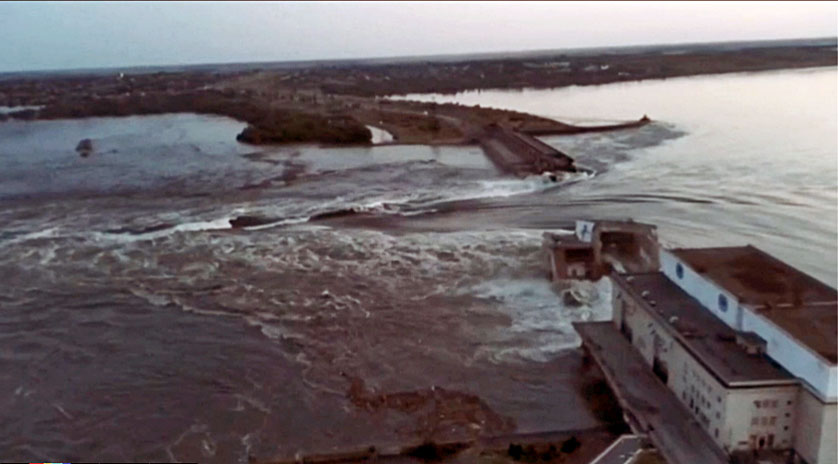In June 2023, the Russian military detonated the walls of the massive Kakhovka Dam, known colloquially as the Kakhovka “reservoir” or “sea”, in the war-ravaged regions of Zaporizhzhia, Dnipro and Kherson in eastern Ukraine.
The reservoir spanned more than 2,000km², was 240km long and contained more than 18km³ of water. By comparison, South Africa’s largest dam, the Gariep, is tiny, having a surface area of about 370km² when full, is less than 100 kilometres long and has a capacity of just more than 5.3km³.
The resultant flood had catastrophic consequences for the villages in the area. Tens of thousands of people were displaced, houses were destroyed, and agrarian land, crops and livestock were flooded and washed away.
Apart from the loss of drinking water, a particularly disturbing aspect of the damage caused was the destruction of the source of water for the cooling pond of the Zaporizhzhia Nuclear Power Plant, Europe’s largest nuclear power station, built during the communist era. A sad irony is that there was minimal military advantage to Russia gained by this destructive act.
The extensive environmental damage and loss of biodiversity was investigated by experts from UNEP (United Nations Environment Programme). They reported that the breach of the dam in June 2023 was a far-reaching environmental disaster that goes beyond Ukraine’s borders.
Much of the damage to ecosystems in and around the Kakhovka reservoir is highly likely to be irreversible and at least some badly damaged habitats will take 30 to 40 years to be restored by nature.
A response to such an environmental calamity is to explore the notion of “crimes against the environment” or “damage to ecological systems” as a crime recognised in international law. The seeds of this idea are in the Statute of Rome, which established the International Criminal Court (ICC) in 2002.
This had the overall intent to deal with international war crimes committed by individuals. The ICC must be distinguished from the International Court of Justice based in the Hague, which by and large deals with interstate disputes.
The consequences of the destruction of the Kakhovka Dam, including the possibility of indicting the perpetrators for a “war crime” before the ICC, was the focus of discussion at a recent colloquium held at the Global Environmental Law Centre at the University of the Western Cape.
The seminar was convened by the Friends of Ukraine Association and attended by South African and Ukrainian environmental activists and lawyers.
 Satellite images of Ukraine’s Kakhovka Dam before and after its destruction. (Images: Al Jazeera)
Satellite images of Ukraine’s Kakhovka Dam before and after its destruction. (Images: Al Jazeera)
Under discussion was the fact that the Rome Statute is underpinned by the foundation of four core international crimes: genocide, crimes against humanity, war crimes and crimes of aggression. The definition of each is expanded on in the statute.
The notion of damage to the environment being a “war crime” is referred to in article 8 of the Rome Statute which elaborates on a war crime as:
“Intentionally launching an attack in the knowledge that such attack will cause incidental loss of life or injury to civilians or damage to civilian objects or widespread, long-term and severe damage to the natural environment which would clearly be excessive in relation to the concrete and direct overall military advantage anticipated.”
Environmental crime has not been prosecuted before in the ICC. In the case of the Kakhovka Dam, at the request of Ukraine, prosecutorial teams at the ICC are investigating individuals allegedly responsible for committing the war crime of “directing attacks at civilian objects resulting in environmental damage”. A further article of the Rome Statute holds that “wilfully causing great suffering, or serious injury to body or health” may amount to a crime against humanity.
Academics and experts have in the meantime been toying with the related notion of “ecocide”. While this is not yet a generally accepted legal term, it loosely means “unlawful or wanton acts committed with knowledge that there is a substantial likelihood of either severe and widespread or long-term damage to the environment caused by those acts”. This aptly describes the Kakhovka Dam case.
Read more: War in Ukraine
Fundamental criminal law principles dictate that to prove a crime, intention must be proved. This can take the form of direct intent or negligence. In this case, the investigating Ukrainian team has compelling evidence that there was a clear intention to blow up the dam and, if not direct intent, then knowledge and recklessness in relation to the possible environmental and other harm is evident.
The notions of “crimes against humanity” and “genocide” were unknown to the international law community after the ravages of World War 2. The efforts of two international lawyers, Eli Lauterpacht and Raphael Lemkin, resulted in these definitions being accepted and invoked at the Nuremberg Trials.
Perhaps it was not a coincidence that these two men studied at the Iwano Frankovsk university which today is in Ukraine. Hopefully, the Ukrainian-trained lawyers, with the assistance of other legal experts, will continue to forge the international judicial path and put the notion of “environmental crime” or “ecocide” on the international judicial map. In this way it is hoped that the destruction of the dam will at least have a positive outcome. DM
Emeritus Professor Jan Glazewski was in the Institute of Marine and Environmental Law at the University of Cape Town. He played a significant role in the inclusion of environmental rights in both the Namibian and South African constitutions.




 Satellite images show Ukraine’s Kakhovka Dam after destruction. (Images: Al Jazeera)
Satellite images show Ukraine’s Kakhovka Dam after destruction. (Images: Al Jazeera)